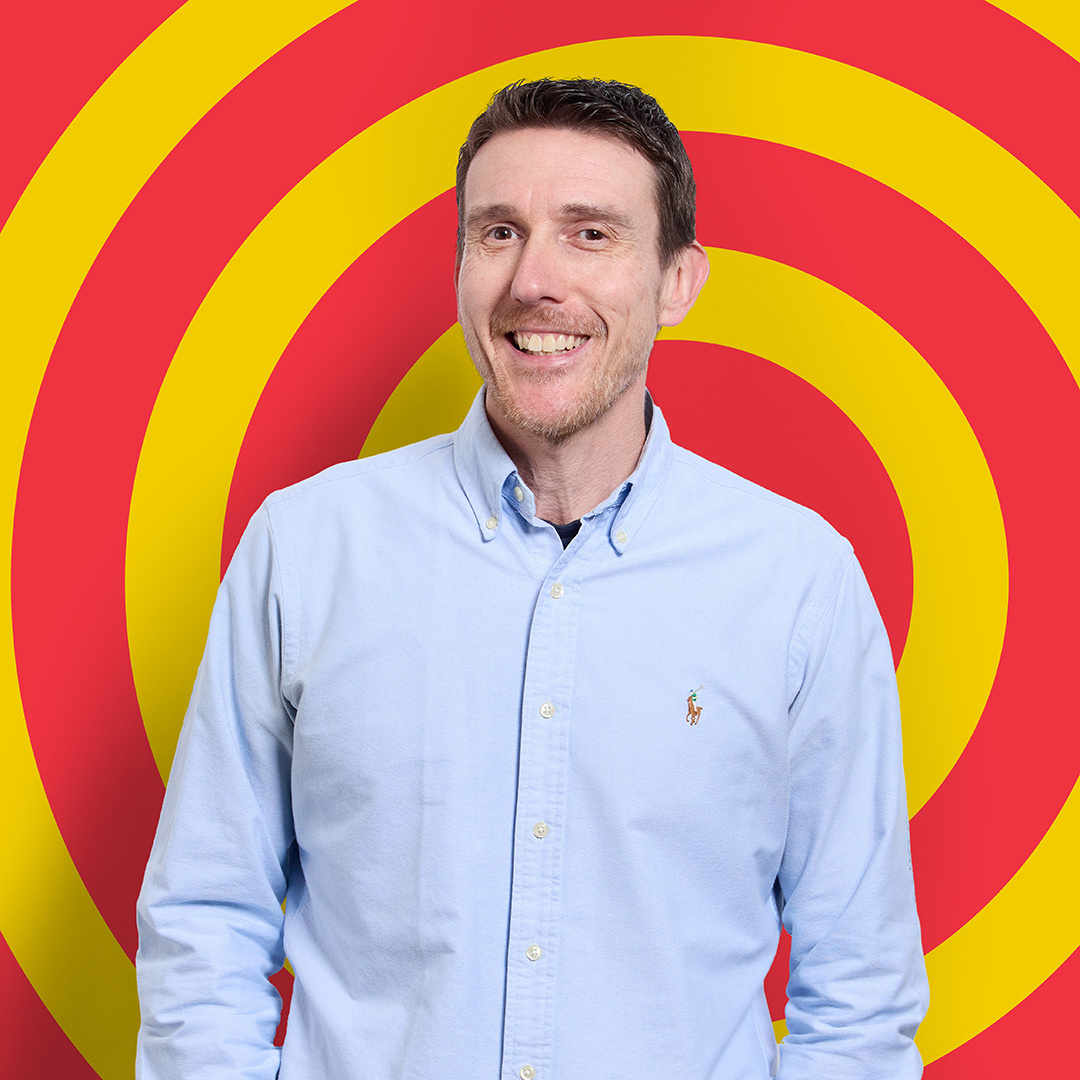Related Case Studies
Related Webinar
World Employer Branding Day 2025: People, purpose and the power of authenticity.

As a first timer at World Employer Branding Day, I volunteered to write up an overview of my thoughts, key takeaways and insights. A simple enough task until 1. you're faced with that daunting blank page and 2. one of the talks on the day included a Content Principle Framework from the guy who helped put Steven Bartlett on the map . . .
So let's start there and put insight in to action. Ash Jones, Personal Brand Advisor & Founder at Great Influence, shared the following four Content Principles:
- Does the world need to hear this from me today?
World Employer Branding Day only took place last week so will still be fresh in people's minds. All of the immediate ‘thank you’, ‘great seeing you’, ‘what a fab event’ etc. posts have all been posted so the thoughts, feelings and key takeaways from a 15+ year experienced employer brand and attraction specialist who attended the event for the first time should (hopefully) be of interest. If not to the world, to those within recruitment marketing and employer branding who either attended the event or didn't get chance to this year. So ‘yes’ to this one.
- Am I repeating the news or adding another lens?
This is the point that resonated most with me. So often when I've attended an event, I tend to post a summary of the key insights/trends from the talks given along with the majority of the other people who have attended the same event. So if you want a summary of what went on and a general round up of themes from the talks, the World Employer Branding Day website has done a great job of it - https://www.worldemployerbrandingday.community/
What I'm going to share are my own personal thoughts and feelings about the event and the key insights I took from it and what I'm going to focus on at SMRS and with my clients.
- Should I be saying this?
Yes. I was there. I'm a highly experienced employer brand professional. And I was a first timer so have a unique perspective on what went on.
- What does great content look, feel and sound like on the platform I'm playing on?
If not in full format, this content will be promoted across LinkedIn in one way or another so according to the platform itself, here's what it needs to look, feel and sound like:
It needs to engage, educate and inspire. It should be educational and actionable. Content should include a saveable and shareable visual (please use this framework). And it should be authentic.
So here goes . . .
Having attended many events over the years, seeing a lot of the same faces and hearing a lot of the same talks, the most refreshing thing about World Employer Branding Day is the truly global nature of it. On the evening before the event, SMRS hosted a dinner and on my table alone I had the pleasure of talking to people from Romania, Turkey, Brazil, Germany and the UK. And on the day itself there was representation from as far as China, India, Australia and everywhere in between. This is a truly global event that employer brand professionals from around the world look forward to, fully embrace and look to learn from. I also had the pleasure of meeting a few of my clients in person.
It was also refreshing that there was a set agenda of talks that everyone attended. This meant that all speakers got to share their great work and insights with everyone and as such the content had to be on point, relevant and engaging.
Most achieved this however a few personal highlights of mine were the talks from Kristin Shulman and Sandra Petschar at Booking.com, Ken Callebaut from Fantastic who spoke with Nathalie Adam at Belgium Federal Police, Steven Ehrlich from Radancy and Kornelia Kiss at TUI, Ash Jones (as mentioned already) and of course Sarah Sturgess from SMRS and Andy Paterson from Lego.
I've earmarked these in particular as these are the talks I took my key insights away from. And here they are:
Leaders aren't just there to get buy in from at the outset of an EB project and then re-engaged with for sign off or if more budget is needed. People trust people more than brands and in many cases leaders in a business have more of a following than the companies they work for, so they need to become employer brand ambassadors, creating content and sharing it across their own profiles. However, this is easier said than done. Just because a leader is adept at running a business/department in one doesn't make them a social content expert. Training is needed. The same type of training you'd give to any ambassador so they're comfortable and confident about what you're asking them to do, and it doesn't simply become another thing to do on their list or a token reshare of existing content. Ash's framework is a great starting point here. And there are experts who focus purely in this area and can support with setting leaders up for success on social, including Kayla Brinkley from Real Chemistry who I met at the event.
AI isn't just a means to drive efficiency. It's quickly becoming the way candidates are searching for jobs, finding out about companies and expecting to be able to search for and be presented with content.
So not only do you need to make sure your careers site and content is optimised to appear across Google and Indeed etc. but you also need to make sure your content is accessible and optimised for Chat GPT and other AI platforms.
Candidates want to be able to search for jobs (on job sites and careers sites) based on what they're looking for and what their experience is and to be shown relevant roles rather than having to search for jobs based on specific keyword strings and then trawl through endless amounts of jobs that aren't relevant to them.
They also want to be shown content in the same way they view it in an AI platform - short, concise and relevant to them.
Is it any wonder 47.2% of people view AI as a threat to their jobs?!
This isn't the point I'm making here, however. Yes, the use of AI is on the rise and will continue to be, so we need to look at how to embrace it, not just use it to drive efficiency in processes but to enhance experiences and marry use of it up with human intervention. An overwhelming theme throughout the event was the importance of people. To quote Ash Jones again: People Buy From People, People Work For People, and People Stay For People.
So let's use AI to provide content in the format that candidates want it in and make sure it's available and optimised to appear on AI platforms but let's make sure that content is created through insight, is on brand and is relevant to the audiences we're trying to attract - Sarah and Andy summed this up perfectly through the various TVP's developed as part of the LEGO Group’s brand evolution.
Trust and authenticity were also recurring themes that came up across a number of the talks, non-more so than during the TUI talk, which summed up the perfect blend of AI and human intervention. While their new careers site is going to be fully AI optimised, the most resounding point made in their talk was around trust and authenticity which is where - any guesses? - their people come in through User Generate Content that will truly bring what it's like to work for TUI to life because People Trust People.
To really drive this point home, Ken Callebaut from Fantastic spoke about the importance of Design Thinking in their approach to a number of campaigns they've developed for the Belgian Federal Police. Design thinking is a human-centered, iterative approach to problem-solving that emphasises understanding user needs and creating innovative solutions. Summed up perfectly by Ken who led on the creative concepts for the campaigns - don't limit creativity with data.
Now, please show me any form of AI that can be powered without data and I'll point you to around 800+ people I had the pleasure of attending WEBD with who are.
Other articles
See all articles-
The End of Algorithmic Adolescence? What Australia’s Ban Means for Brands
Read more 100 -
Winning the global talent war for AI and tech skills
Read more 100 -
What really makes AI work, and what’s holding us back.
Read more 100 -
Transforming applicant engagement using AI
Read more 100 -
World Employer Branding Day 2025: People, purpose and the power of authenticity.
Read more 100 -
Beyond the offer: why universities can’t afford to go quiet in August
Read more 100
Other webinars
See all webinars-
Culture Forward: Shaping the future of workplace culture
{% module_block module "widget_84147eb9-0a83-459f-a092-8d51c83b2b99" %}{% module_attribute "background" is_json="true" %}{"color":"#F1CC01","css":"#F1CC01","hex":"#F1CC01","opacity":100,"rgb":"rgb(241, 204, 1)","rgba":"rgba(241, 204, 1, 1)"}{% end_module_attribute %}{% module_attribute "block1_background_image" is_json="true" %}{"alt":"circle-black","height":262,"loading":"lazy","max_height":262,"max_width":256,"size_type":"auto","src":"https://25966858.fs1.hubspotusercontent-eu1.net/hubfs/25966858/Events%20and%20Our%20Insights/circle-black.png","width":256}{% end_module_attribute %}{% module_attribute "book_your_ticket_url" is_json="true" %}{"content_id":null,"href":"https://share-eu1.hsforms.com/10IkaYDScQ9G1z5tJ_QRMAgfgk5m","href_with_scheme":"https://share-eu1.hsforms.com/10IkaYDScQ9G1z5tJ_QRMAgfgk5m","type":"EXTERNAL"}{% end_module_attribute %}{% module_attribute "child_css" is_json="true" %}{}{% end_module_attribute %}{% module_attribute "choose_presenters" is_json="true" %}[{"columns":{"hs_child_table_id":0,"message":"Hafsa.aziz@smrs.co.uk","call_back":"https://meetings-eu1.hubspot.com/meetings/hafsa-aziz/meeting-with-hafsa-sophia-?uuid=904d4d0c-e24d-4e5c-93c7-6f92523888fd","hs_is_edited":false,"hs_updated_at":1750860099444,"name":"Hafsa Aziz","hs_deleted_at":0,"team_name":"Culture Consultant","hs_id":233870773448,"hs_created_by_user_id":67876044,"hs_initial_published_at":1746517555970,"hs_published_at":1762504949284,"hs_created_at":1746517504074,"linkedin":"https://uk.linkedin.com/in/hafsa-aziz-57803b92","picture":{"altText":"Hafsa_0000_1080","fileId":112133140983,"height":4644,"type":"image","url":"https://25966858.fs1.hubspotusercontent-eu1.net/hubfs/25966858/Hafsa_0000_1080.jpg","width":4644},"hs_updated_by_user_id":60647974},"id":233870773448,"table_id":483015920,"table_name":"presenters"},{"columns":{"hs_child_table_id":0,"message":"richard.badley@smrs.co.uk","call_back":"https://meetings-eu1.hubspot.com/richard-badley","hs_is_edited":false,"hs_updated_at":1750859575521,"name":"Richard Badley","hs_deleted_at":0,"team_name":"Director","hs_id":233870773447,"hs_created_by_user_id":67876044,"hs_initial_published_at":1746517555970,"hs_published_at":1762504949284,"hs_created_at":1746517504051,"linkedin":"https://uk.linkedin.com/in/richardbadley","picture":{"altText":"Richard B _CW_2348_1080px","fileId":107594154954,"height":1080,"type":"image","url":"https://25966858.fs1.hubspotusercontent-eu1.net/hubfs/25966858/Richard%20B%20_CW_2348_1080px.jpg","width":1080},"hs_updated_by_user_id":60647974},"id":233870773447,"table_id":483015920,"table_name":"presenters"}]{% end_module_attribute %}{% module_attribute "css" is_json="true" %}{}{% end_module_attribute %}{% module_attribute "definition_id" is_json="true" %}null{% end_module_attribute %}{% module_attribute "event_date_and_time" is_json="true" %}1768914000000{% end_module_attribute %}{% module_attribute "event_date_color" is_json="true" %}{"color":"#ffffff","css":"#ffffff","hex":"#ffffff","opacity":100,"rgb":"rgb(255, 255, 255)","rgba":"rgba(255, 255, 255, 1)"}{% end_module_attribute %}{% module_attribute "field_types" is_json="true" %}{"event_date_and_time":"datetime","select_event_type":"choice","paragraph_text_color":"color","tag_to_be_displayed":"tag","block1_background_image":"image","custom_class":"text","cta_button_text":"text","min_height_mobile":"number","disable_section":"boolean","background":"color","paragraph":"richtext","min_height_desktop":"number","book_your_ticket_url":"url","placeholder":"image","choose_presenters":"hubdbrow","embed_video":"boolean","vimeo_id":"text","event_date_color":"color","headline_text":"text","share_link":"link","linkedin_link":"link","headline_text_color":"color","hide_book_your_ticket":"boolean"}{% end_module_attribute %}{% module_attribute "headline_text" is_json="true" %}"Culture Forward: Trends, tools, and connections shaping the future of workplace culture "{% end_module_attribute %}{% module_attribute "headline_text_color" is_json="true" %}{"color":"#000000","css":"#000000","hex":"#000000","opacity":100,"rgb":"rgb(0, 0, 0)","rgba":"rgba(0, 0, 0, 1)"}{% end_module_attribute %}{% module_attribute "hide_book_your_ticket" is_json="true" %}false{% end_module_attribute %}{% module_attribute "label" is_json="true" %}null{% end_module_attribute %}{% module_attribute "module_id" is_json="true" %}236642190552{% end_module_attribute %}{% module_attribute "paragraph" is_json="true" %}" "{% end_module_attribute %}{% module_attribute "path" is_json="true" %}"/smrs/website-theme/modules/pages/Hero_Banner_with_Fusion_Video"{% end_module_attribute %}{% module_attribute "placeholder" is_json="true" %}{"alt":"hafsa","height":1080,"max_height":1080,"max_width":1920,"size_type":"exact","src":"https://25966858.fs1.hubspotusercontent-eu1.net/hubfs/25966858/hafsa.jpg","width":1920}{% end_module_attribute %}{% module_attribute "schema_version" is_json="true" %}2{% end_module_attribute %}{% module_attribute "smart_objects" is_json="true" %}null{% end_module_attribute %}{% module_attribute "smart_type" is_json="true" %}"NOT_SMART"{% end_module_attribute %}{% module_attribute "tag" is_json="true" %}"module"{% end_module_attribute %}{% module_attribute "tag_to_be_displayed" is_json="true" %}"employer"{% end_module_attribute %}{% module_attribute "type" is_json="true" %}"module"{% end_module_attribute %}{% module_attribute "vimeo_id" is_json="true" %}""{% end_module_attribute %}{% module_attribute "wrap_field_tag" is_json="true" %}"div"{% end_module_attribute %}{% end_module_block %} {% module_block module "widget_34c28e40-baae-433a-93b4-b003fa74d80c" %}{% module_attribute "accordion" is_json="true" %}false{% end_module_attribute %}{% module_attribute "add_custom_class" is_json="true" %}"blogTopicCovered "{% end_module_attribute %}{% module_attribute "align_items" is_json="true" %}"align-items-start"{% end_module_attribute %}{% module_attribute "background" is_json="true" %}{"color":"#008486","css":"#008486","hex":"#008486","opacity":100,"rgb":"rgb(0, 132, 134)","rgba":"rgba(0, 132, 134, 1)"}{% end_module_attribute %}{% module_attribute "background_image" is_json="true" %}{"alt":"yellow-square-full","height":186,"loading":"lazy","max_height":186,"max_width":155,"size_type":"auto","src":"https://25966858.fs1.hubspotusercontent-eu1.net/hubfs/25966858/Events%20and%20Our%20Insights/yellow-square-full.png","width":155}{% end_module_attribute %}{% module_attribute "child_css" is_json="true" %}{}{% end_module_attribute %}{% module_attribute "content_alignment" is_json="true" %}"justify-content-center"{% end_module_attribute %}{% module_attribute "css" is_json="true" %}{}{% end_module_attribute %}{% module_attribute "definition_id" is_json="true" %}null{% end_module_attribute %}{% module_attribute "field_types" is_json="true" %}{"show_our_work_talk_to_expert_link":"boolean","align_items":"choice","hero_block":"boolean","accordion":"boolean","add_custom_class":"text","set_headline_as_h1":"boolean","background_image":"image","max_width":"number","block_id":"text","background":"color","paragraph":"richtext","background_on_mobile":"color","style":"group","healine_text":"text","min_height":"number","headline_spacing":"boolean","title":"text","field_group":"group","content_alignment":"choice","display_condition":"choice"}{% end_module_attribute %}{% module_attribute "healine_text" is_json="true" %}""{% end_module_attribute %}{% module_attribute "label" is_json="true" %}null{% end_module_attribute %}{% module_attribute "max_width" is_json="true" %}1800{% end_module_attribute %}{% module_attribute "min_height" is_json="true" %}300{% end_module_attribute %}{% module_attribute "module_id" is_json="true" %}106628715223{% end_module_attribute %}{% module_attribute "paragraph" is_json="true" %}"
Today’s culture leaders operate at a pivotal moment. Hybrid work, evolving employee expectations, and the acceleration of AI have transformed culture from a “nice to have” into a true strategic edge. This session creates space to step back, exchange perspectives, and connect with peers navigating the same landscape.
\nWatch webinar 100 -
Establishing the right cultural foundations for your Employer Brand in the UAE
{% module_block module "widget_84147eb9-0a83-459f-a092-8d51c83b2b99" %}{% module_attribute "background" is_json="true" %}{% raw %}{"color":"#F1CC01","css":"#F1CC01","hex":"#F1CC01","opacity":100,"rgb":"rgb(241, 204, 1)","rgba":"rgba(241, 204, 1, 1)"}{% end_module_attribute %}{% module_attribute "block1_background_image" is_json="true" %}{"alt":"circle-black","height":262,"loading":"lazy","max_height":262,"max_width":256,"size_type":"auto","src":"https://25966858.fs1.hubspotusercontent-eu1.net/hubfs/25966858/Events%20and%20Our%20Insights/circle-black.png","width":256}{% end_module_attribute %}{% module_attribute "book_your_ticket_url" is_json="true" %}{"content_id":null,"href":"https://share-eu1.hsforms.com/1GOa0jzHqRUeimsBRb4i1mgfgk5m","href_with_scheme":"https://share-eu1.hsforms.com/1GOa0jzHqRUeimsBRb4i1mgfgk5m","type":"EXTERNAL"}{% end_module_attribute %}{% module_attribute "child_css" is_json="true" %}{}{% end_module_attribute %}{% module_attribute "choose_presenters" is_json="true" %}[{"columns":{"hs_child_table_id":0,"message":"Hafsa.aziz@smrs.co.uk","call_back":"https://meetings-eu1.hubspot.com/meetings/hafsa-aziz/meeting-with-hafsa-sophia-?uuid=904d4d0c-e24d-4e5c-93c7-6f92523888fd","hs_is_edited":false,"hs_updated_at":1750860099444,"name":"Hafsa Aziz","hs_deleted_at":0,"team_name":"Culture Consultant","hs_id":233870773448,"hs_created_by_user_id":67876044,"hs_initial_published_at":1746517555970,"hs_published_at":1762504949284,"hs_created_at":1746517504074,"linkedin":"https://uk.linkedin.com/in/hafsa-aziz-57803b92","picture":{"altText":"Hafsa_0000_1080","fileId":112133140983,"height":4644,"type":"image","url":"https://25966858.fs1.hubspotusercontent-eu1.net/hubfs/25966858/Hafsa_0000_1080.jpg","width":4644},"hs_updated_by_user_id":60647974},"id":233870773448,"table_id":483015920,"table_name":"presenters"},{"columns":{"hs_child_table_id":0,"message":"sarah.sturgess@smrs.co.uk","call_back":"https://meetings-eu1.hubspot.com/sarah-sturgess","hs_is_edited":false,"hs_updated_at":1750860292837,"name":"Sarah Sturgess ","hs_deleted_at":0,"team_name":"Director","hs_id":233870773454,"hs_created_by_user_id":67876044,"hs_initial_published_at":1746517555970,"hs_published_at":1762504949284,"hs_created_at":1746517504163,"linkedin":"https://uk.linkedin.com/in/sarahsturgess","picture":{"altText":"Sarah _CW_1558_1080px (1)","fileId":107594154968,"height":1080,"type":"image","url":"https://25966858.fs1.hubspotusercontent-eu1.net/hubfs/25966858/Sarah%20_CW_1558_1080px%20(1).jpg","width":1080},"hs_updated_by_user_id":60647974},"id":233870773454,"table_id":483015920,"table_name":"presenters"}]{% end_module_attribute %}{% module_attribute "css" is_json="true" %}{}{% end_module_attribute %}{% module_attribute "definition_id" is_json="true" %}null{% end_module_attribute %}{% module_attribute "event_date_and_time" is_json="true" %}1765202400000{% end_module_attribute %}{% module_attribute "event_date_color" is_json="true" %}{"color":"#ffffff","css":"#ffffff","hex":"#ffffff","opacity":100,"rgb":"rgb(255, 255, 255)","rgba":"rgba(255, 255, 255, 1)"}{% end_module_attribute %}{% module_attribute "field_types" is_json="true" %}{"event_date_and_time":"datetime","select_event_type":"choice","paragraph_text_color":"color","tag_to_be_displayed":"tag","block1_background_image":"image","custom_class":"text","cta_button_text":"text","min_height_mobile":"number","disable_section":"boolean","background":"color","paragraph":"richtext","min_height_desktop":"number","book_your_ticket_url":"url","placeholder":"image","choose_presenters":"hubdbrow","embed_video":"boolean","vimeo_id":"text","event_date_color":"color","headline_text":"text","share_link":"link","linkedin_link":"link","headline_text_color":"color","hide_book_your_ticket":"boolean"}{% end_module_attribute %}{% module_attribute "headline_text" is_json="true" %}"Establishing the right cultural foundations for your Employer Brand in the UAE"{% end_module_attribute %}{% module_attribute "headline_text_color" is_json="true" %}{"color":"#000000","css":"#000000","hex":"#000000","opacity":100,"rgb":"rgb(0, 0, 0)","rgba":"rgba(0, 0, 0, 1)"}{% end_module_attribute %}{% module_attribute "hide_book_your_ticket" is_json="true" %}false{% end_module_attribute %}{% module_attribute "label" is_json="true" %}null{% end_module_attribute %}{% module_attribute "module_id" is_json="true" %}236642190552{% end_module_attribute %}{% module_attribute "paragraph" is_json="true" %}" "{% end_module_attribute %}{% module_attribute "path" is_json="true" %}"/smrs/website-theme/modules/pages/Hero_Banner_with_Fusion_Video"{% end_module_attribute %}{% module_attribute "placeholder" is_json="true" %}{"alt":"iStock-913519636","height":795,"max_height":795,"max_width":1320,"size_type":"auto_custom_max","src":"https://25966858.fs1.hubspotusercontent-eu1.net/hubfs/25966858/iStock-913519636.jpg","width":1320}{% end_module_attribute %}{% module_attribute "schema_version" is_json="true" %}2{% end_module_attribute %}{% module_attribute "smart_objects" is_json="true" %}null{% end_module_attribute %}{% module_attribute "smart_type" is_json="true" %}"NOT_SMART"{% end_module_attribute %}{% module_attribute "tag" is_json="true" %}"module"{% end_module_attribute %}{% module_attribute "tag_to_be_displayed" is_json="true" %}"employer"{% end_module_attribute %}{% module_attribute "type" is_json="true" %}"module"{% end_module_attribute %}{% module_attribute "vimeo_id" is_json="true" %}""{% end_module_attribute %}{% module_attribute "wrap_field_tag" is_json="true" %}"div"{% end_module_attribute %}{% end_module_block %} {% module_block module "widget_34c28e40-baae-433a-93b4-b003fa74d80c" %}{% module_attribute "accordion" is_json="true" %}false{% end_module_attribute %}{% module_attribute "add_custom_class" is_json="true" %}"blogTopicCovered "{% end_module_attribute %}{% module_attribute "align_items" is_json="true" %}"align-items-start"{% end_module_attribute %}{% module_attribute "background" is_json="true" %}{"color":"#008486","css":"#008486","hex":"#008486","opacity":100,"rgb":"rgb(0, 132, 134)","rgba":"rgba(0, 132, 134, 1)"}{% end_module_attribute %}{% module_attribute "background_image" is_json="true" %}{"alt":"yellow-square-full","height":186,"loading":"lazy","max_height":186,"max_width":155,"size_type":"auto","src":"https://25966858.fs1.hubspotusercontent-eu1.net/hubfs/25966858/Events%20and%20Our%20Insights/yellow-square-full.png","width":155}{% end_module_attribute %}{% module_attribute "child_css" is_json="true" %}{}{% end_module_attribute %}{% module_attribute "content_alignment" is_json="true" %}"justify-content-center"{% end_module_attribute %}{% module_attribute "css" is_json="true" %}{}{% end_module_attribute %}{% module_attribute "definition_id" is_json="true" %}null{% end_module_attribute %}{% module_attribute "field_types" is_json="true" %}{"show_our_work_talk_to_expert_link":"boolean","align_items":"choice","hero_block":"boolean","accordion":"boolean","add_custom_class":"text","set_headline_as_h1":"boolean","background_image":"image","max_width":"number","block_id":"text","background":"color","paragraph":"richtext","background_on_mobile":"color","style":"group","healine_text":"text","min_height":"number","headline_spacing":"boolean","title":"text","field_group":"group","content_alignment":"choice","display_condition":"choice"}{% end_module_attribute %}{% module_attribute "healine_text" is_json="true" %}""{% end_module_attribute %}{% module_attribute "label" is_json="true" %}null{% end_module_attribute %}{% module_attribute "max_width" is_json="true" %}1800{% end_module_attribute %}{% module_attribute "min_height" is_json="true" %}300{% end_module_attribute %}{% module_attribute "module_id" is_json="true" %}106628715223{% end_module_attribute %}{% module_attribute "paragraph" is_json="true" %}"
In today’s competitive talent landscape, UAE-based employers need to develop an EVP that’s fit for purpose to attract and retain high quality talent.
\nWatch webinar 100
In person events
See all events-
.jpg)
Video Creation Masterclass with JonesMillbank & SMRS
{% module_block module "widget_84147eb9-0a83-459f-a092-8d51c83b2b99" %}{% module_attribute "background" is_json="true" %}{% raw %}{"color":"#F1CC01","css":"#F1CC01","hex":"#F1CC01","opacity":100,"rgb":"rgb(241, 204, 1)","rgba":"rgba(241, 204, 1, 1)"}{% end_module_attribute %}{% module_attribute "block1_background_image" is_json="true" %}{"alt":"circle-black","height":262,"loading":"lazy","max_height":262,"max_width":256,"size_type":"auto","src":"https://25966858.fs1.hubspotusercontent-eu1.net/hubfs/25966858/Events%20and%20Our%20Insights/circle-black.png","width":256}{% end_module_attribute %}{% module_attribute "book_your_ticket_url" is_json="true" %}{"content_id":null,"href":"https://share-eu1.hsforms.com/2DCFUJqv4QRqeygI1rYekiAfgk5m","href_with_scheme":"https://share-eu1.hsforms.com/2DCFUJqv4QRqeygI1rYekiAfgk5m","type":"EXTERNAL"}{% end_module_attribute %}{% module_attribute "child_css" is_json="true" %}{}{% end_module_attribute %}{% module_attribute "choose_presenters" is_json="true" %}[{"columns":{"hs_child_table_id":0,"message":"sarah.sturgess@smrs.co.uk","call_back":"https://meetings-eu1.hubspot.com/sarah-sturgess","hs_is_edited":false,"hs_updated_at":1750860292837,"name":"Sarah Sturgess ","hs_deleted_at":0,"team_name":"Director","hs_id":233870773454,"hs_created_by_user_id":67876044,"hs_initial_published_at":1746517555970,"hs_published_at":1762504949284,"hs_created_at":1746517504163,"linkedin":"https://uk.linkedin.com/in/sarahsturgess","picture":{"altText":"Sarah _CW_1558_1080px (1)","fileId":107594154968,"height":1080,"type":"image","url":"https://25966858.fs1.hubspotusercontent-eu1.net/hubfs/25966858/Sarah%20_CW_1558_1080px%20(1).jpg","width":1080},"hs_updated_by_user_id":60647974},"id":233870773454,"table_id":483015920,"table_name":"presenters"},null]{% end_module_attribute %}{% module_attribute "css" is_json="true" %}{}{% end_module_attribute %}{% module_attribute "definition_id" is_json="true" %}null{% end_module_attribute %}{% module_attribute "event_date_and_time" is_json="true" %}1769085000000{% end_module_attribute %}{% module_attribute "event_date_color" is_json="true" %}{"color":"#ffffff","css":"#ffffff","hex":"#ffffff","opacity":100,"rgb":"rgb(255, 255, 255)","rgba":"rgba(255, 255, 255, 1)"}{% end_module_attribute %}{% module_attribute "field_types" is_json="true" %}{"event_date_and_time":"datetime","select_event_type":"choice","paragraph_text_color":"color","tag_to_be_displayed":"tag","block1_background_image":"image","custom_class":"text","cta_button_text":"text","min_height_mobile":"number","disable_section":"boolean","background":"color","paragraph":"richtext","min_height_desktop":"number","book_your_ticket_url":"url","placeholder":"image","choose_presenters":"hubdbrow","embed_video":"boolean","vimeo_id":"text","event_date_color":"color","headline_text":"text","share_link":"link","linkedin_link":"link","headline_text_color":"color","hide_book_your_ticket":"boolean"}{% end_module_attribute %}{% module_attribute "headline_text" is_json="true" %}"Video Creation Masterclass with JonesMillbank & SMRS "{% end_module_attribute %}{% module_attribute "headline_text_color" is_json="true" %}{"color":"#000000","css":"#000000","hex":"#000000","opacity":100,"rgb":"rgb(0, 0, 0)","rgba":"rgba(0, 0, 0, 1)"}{% end_module_attribute %}{% module_attribute "hide_book_your_ticket" is_json="true" %}false{% end_module_attribute %}{% module_attribute "label" is_json="true" %}null{% end_module_attribute %}{% module_attribute "module_id" is_json="true" %}236642190552{% end_module_attribute %}{% module_attribute "paragraph" is_json="true" %}" "{% end_module_attribute %}{% module_attribute "path" is_json="true" %}"/smrs/website-theme/modules/pages/Hero_Banner_with_Fusion_Video"{% end_module_attribute %}{% module_attribute "placeholder" is_json="true" %}{"alt":"Video studio masterclass no people no words and more of a full studio-1","height":1024,"max_height":1024,"max_width":1024,"size_type":"auto_custom_max","src":"https://25966858.fs1.hubspotusercontent-eu1.net/hubfs/25966858/AI-Generated%20Media/Images/Video%20studio%20masterclass%20%20no%20people%20no%20words%20and%20more%20of%20a%20full%20studio-1.png","width":1024}{% end_module_attribute %}{% module_attribute "schema_version" is_json="true" %}2{% end_module_attribute %}{% module_attribute "select_event_type" is_json="true" %}"In-person"{% end_module_attribute %}{% module_attribute "smart_objects" is_json="true" %}null{% end_module_attribute %}{% module_attribute "smart_type" is_json="true" %}"NOT_SMART"{% end_module_attribute %}{% module_attribute "tag" is_json="true" %}"module"{% end_module_attribute %}{% module_attribute "tag_to_be_displayed" is_json="true" %}"in-person"{% end_module_attribute %}{% module_attribute "type" is_json="true" %}"module"{% end_module_attribute %}{% module_attribute "vimeo_id" is_json="true" %}""{% end_module_attribute %}{% module_attribute "wrap_field_tag" is_json="true" %}"div"{% end_module_attribute %}{% end_module_block %} {% module_block module "widget_34c28e40-baae-433a-93b4-b003fa74d80c" %}{% module_attribute "accordion" is_json="true" %}false{% end_module_attribute %}{% module_attribute "add_custom_class" is_json="true" %}"blogTopicCovered "{% end_module_attribute %}{% module_attribute "align_items" is_json="true" %}"align-items-start"{% end_module_attribute %}{% module_attribute "background" is_json="true" %}{"color":"#008486","css":"#008486","hex":"#008486","opacity":100,"rgb":"rgb(0, 132, 134)","rgba":"rgba(0, 132, 134, 1)"}{% end_module_attribute %}{% module_attribute "background_image" is_json="true" %}{"alt":"yellow-square-full","height":186,"loading":"lazy","max_height":186,"max_width":155,"size_type":"auto","src":"https://25966858.fs1.hubspotusercontent-eu1.net/hubfs/25966858/Events%20and%20Our%20Insights/yellow-square-full.png","width":155}{% end_module_attribute %}{% module_attribute "child_css" is_json="true" %}{}{% end_module_attribute %}{% module_attribute "content_alignment" is_json="true" %}"justify-content-center"{% end_module_attribute %}{% module_attribute "css" is_json="true" %}{}{% end_module_attribute %}{% module_attribute "definition_id" is_json="true" %}null{% end_module_attribute %}{% module_attribute "field_types" is_json="true" %}{"show_our_work_talk_to_expert_link":"boolean","align_items":"choice","hero_block":"boolean","accordion":"boolean","add_custom_class":"text","set_headline_as_h1":"boolean","background_image":"image","max_width":"number","block_id":"text","background":"color","paragraph":"richtext","background_on_mobile":"color","style":"group","healine_text":"text","min_height":"number","headline_spacing":"boolean","title":"text","field_group":"group","content_alignment":"choice","display_condition":"choice"}{% end_module_attribute %}{% module_attribute "healine_text" is_json="true" %}""{% end_module_attribute %}{% module_attribute "label" is_json="true" %}null{% end_module_attribute %}{% module_attribute "max_width" is_json="true" %}1800{% end_module_attribute %}{% module_attribute "min_height" is_json="true" %}300{% end_module_attribute %}{% module_attribute "module_id" is_json="true" %}106628715223{% end_module_attribute %}{% module_attribute "paragraph" is_json="true" %}{% raw %}"
Video content is everything right now and it’s only becoming more powerful. With search now happening everywhere and AI-driven platforms increasingly surfacing video first, great video isn’t just storytelling anymore it’s discoverability. Your video is now your SEO.
\nView event 100


